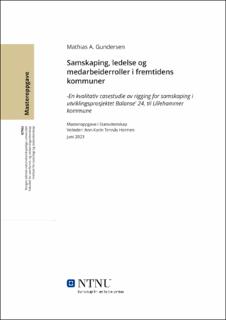| dc.contributor.advisor | Ann-Karin Tennås Holmen | |
| dc.contributor.author | Mathias A Gundersen | |
| dc.date.accessioned | 2023-07-26T17:19:40Z | |
| dc.date.available | 2023-07-26T17:19:40Z | |
| dc.date.issued | 2023 | |
| dc.identifier | no.ntnu:inspera:138964717:91502393 | |
| dc.identifier.uri | https://hdl.handle.net/11250/3081513 | |
| dc.description.abstract | Det norske velferdssamfunnet er under press på grunn av nedgangen i antall arbeidsaktive innbyggere i forhold til antall eldre. Det har oppstått nye samfunnsfloker som nødvendiggjør at kommunene må finne nye løsninger og samarbeid for fremtidige utfordringer. En populær strategi blant kommunene fokuserer på å anvende forskjellige forståelser av samskaping til å utvikle, tilpasse og forberede kommunen for disse utfordringene
.
Denne studien har hatt et fokus på styringsforståelser, samskapingsforståelser, offentlig ledelse og medarbeiderdrevet innovasjon i Lillehammer kommune og Balanse’ 24. Alle disse elementene trender i offentlig sektor, og målet med denne studien har vært å skape bedre forståelse for rollen offentlige ledere og medarbeidere spiller i rigging for samskaping med innbyggerne.
Med dette som utgangspunkt, valgte jeg å gjennomføre en kvalitativ casestudie av Balanse’ 24, hvor dataene stammer fra forskjellige styringsdokumenter, en rapport fra Helse- og Velferds avdelingen, og semistrukturerte intervjuer av en kommunepolitiker og fem ansatte i Lillehammer kommune. Analysen av dokumentene og intervjuene hadde som formål å redegjøre for Balanse’ 24s strategier, ledelse, kompetanse og verktøy, slik at jeg kunne tolke forståelsene, målet og riggingen for samskaping i lys av tidligere litteratur.
Denne studiens funn tilsier at rigging for samskaping fremstilles og forankres i effektivitetsforståelse, men inneholder elementer fra empowermentforståelsen og den innovative bunnlinjen. Jeg tolker at dette påvirker Lillehammer kommunes styringsforståelse, ved at kommunens forståelse befinner seg i et krysspress mellom styringsparadigmene New Public Management og New Public Governance. Dette krysspresset er et resultat av kommunens rigging for samskaping, og bruken av begrepene aktivt medarbeiderskap og tillitsbasert ledelse. Medarbeiderskapet fremmer elementer fra Medarbeiderdrevet innovasjon i samskaping, ved at medarbeiderne skal føle på et aktivt eierskap ved å være entreprenører i tjenesteytingen, mens tillitsbasert ledelse fremmer denne entreprenørisk aktiviteten ved å fokusere mindre på detaljstyring, og mer på etableringen av et innovativt arbeidsmiljø.
Rigging for samskaping vil derfor påvirke kommunens styringssystem, ettersom at forskjellige forståelser av samskaping, innovativ ledelse og etableringen av et entreprenørisk miljø i linjearbeidet til medarbeiderne, vil fremme en styringsutvikling i kommunen. | |
| dc.description.abstract | The Norwegian welfare society is under pressure due to the decline in the number of working-age residents in relation to the number of elderly people. New social entanglements have arisen which make it necessary for the municipalities to find new solutions and collaboration for future challenges. A popular strategy among municipalities focuses on applying different understandings of co-creation to develop, adapt and prepare the municipality for these challenges.
This study has had a focus on understandings of governance, understandings of co-creation, public management, and employee-driven innovation in Lillehammer municipality and Balanse' 24. All these elements are trends in the public sector, and the aim of this study has been to create a better understanding of the role public managers and employees play in rigging for co-creation with the citizens.
With this as a starting point, I chose to carry out a qualitative case study of Balanse' 24, where the data originates from various management documents, a report from the Health and Welfare department, and semi-structured interviews with a municipal politician and five employees in Lillehammer municipality. The purpose of the analysis of the documents and interviews was to explain Balanse' 24's strategies, management, expertise, and tools, so that I could interpret the understandings, the goal, and the rigging for co-creation in light of previous literature.
This study's findings indicate that rigging for co-creation is produced and anchored in an understanding of efficiency but contains elements from the understanding of empowerment and the innovative bottom line. I interpret that this affects Lillehammer municipality's understanding of governance, in that the municipality's understanding is in a cross-pressure between the governance paradigms New Public Management and New Public Governance. This cross-pressure is a result of the municipality's rigging for co-creation, and the use of the terms active employeeship and trust-based management. The employeeship promotes elements of Employee-driven innovation in co-creation, in that the employees should feel an active ownership by being entrepreneurs in the provision of services, while trust-based management promotes this entrepreneurial activity by focusing less on detailed management, and more on the establishment of an innovative working environment.
Rigging for co-creation will therefore affect the municipality's management system, as different understandings of co-creation, innovative management, and the establishment of an entrepreneurial environment in the line work of employees will promote management development in the municipality. | |
| dc.language | nob | |
| dc.publisher | NTNU | |
| dc.title | Samskaping, ledelse og medarbeiderroller i fremtidens kommuner: -En kvalitativ casestudie av rigging for samskaping i utviklingsprosjektet Balanse' 24, til Lillehammer kommune | |
| dc.type | Master thesis | |
